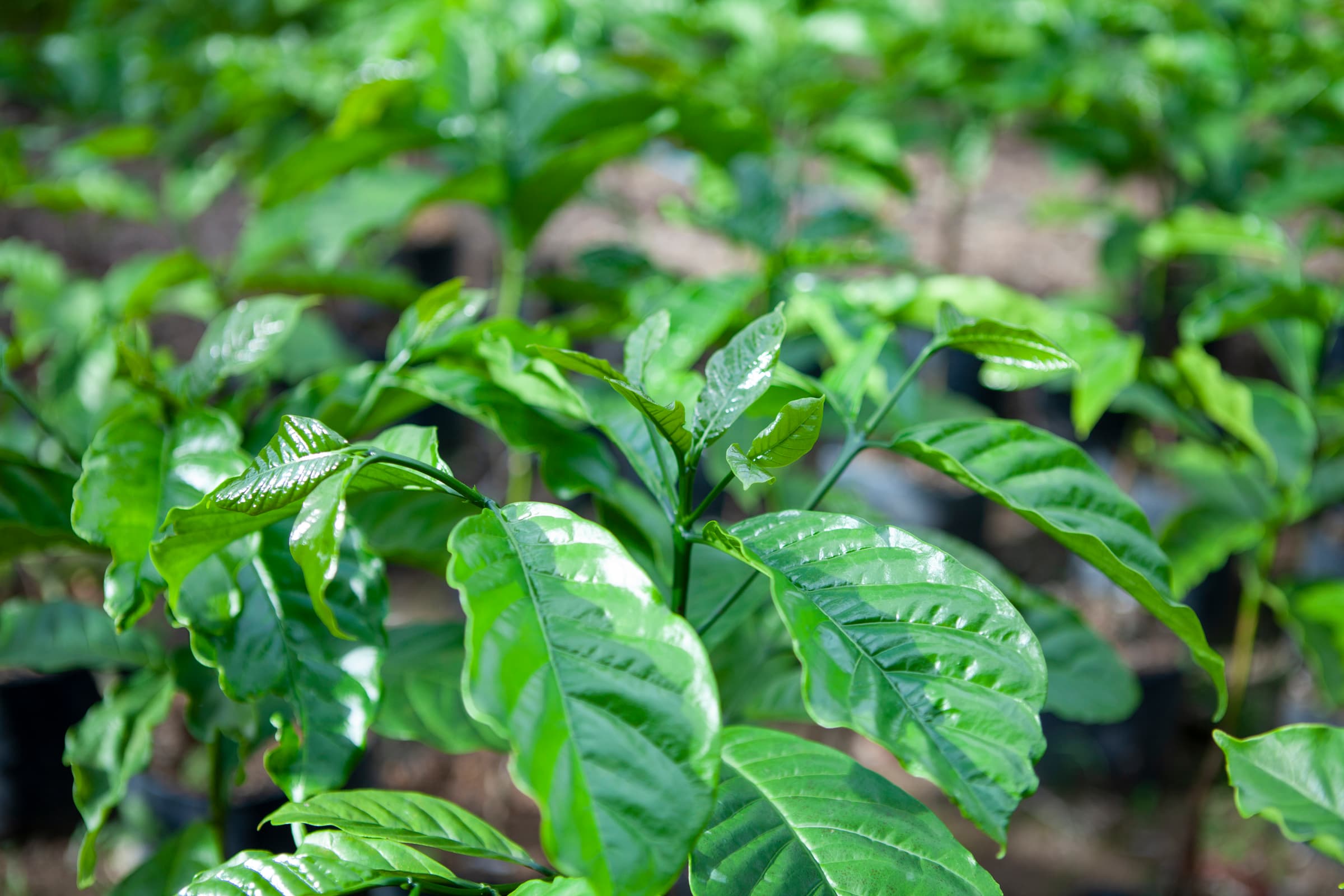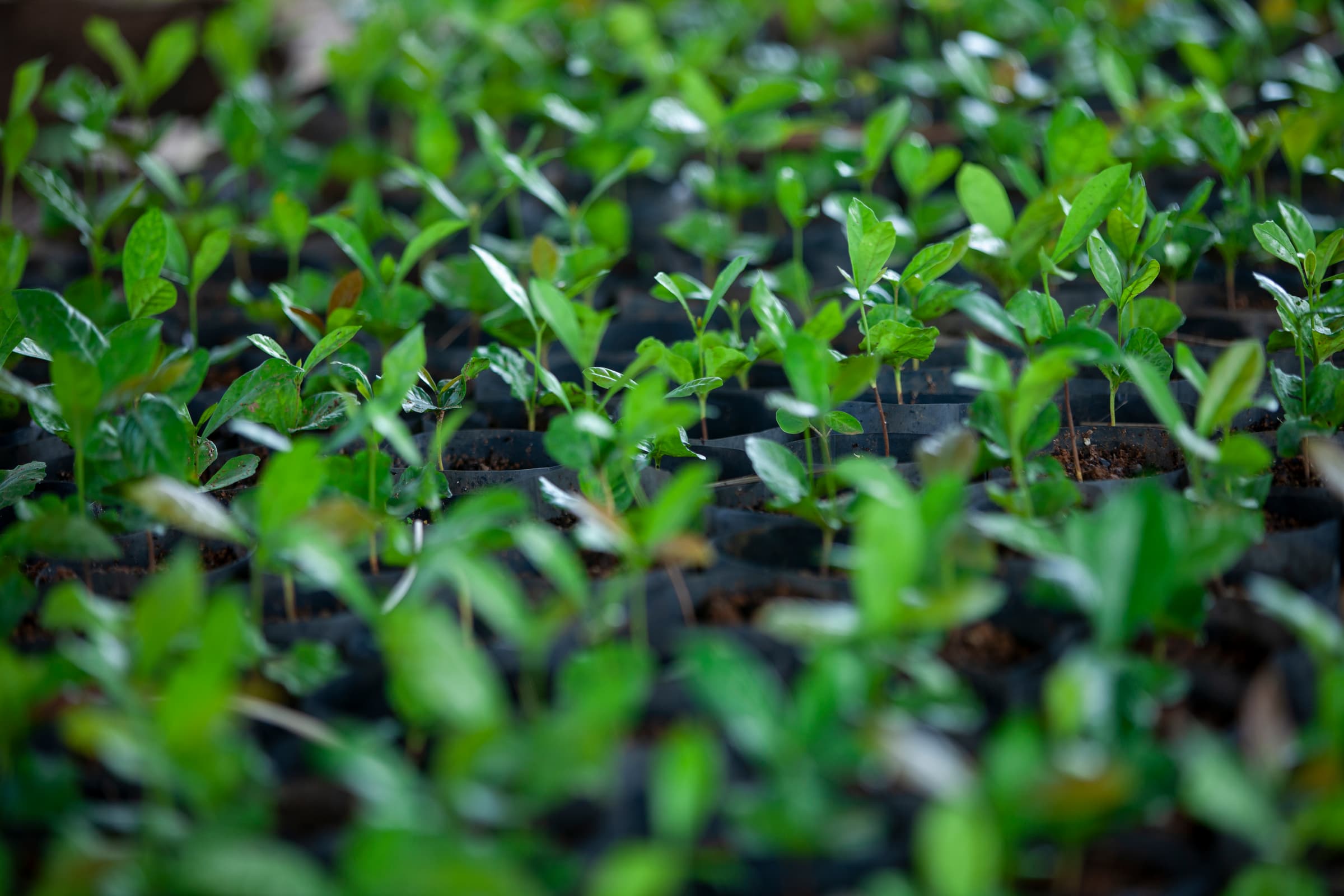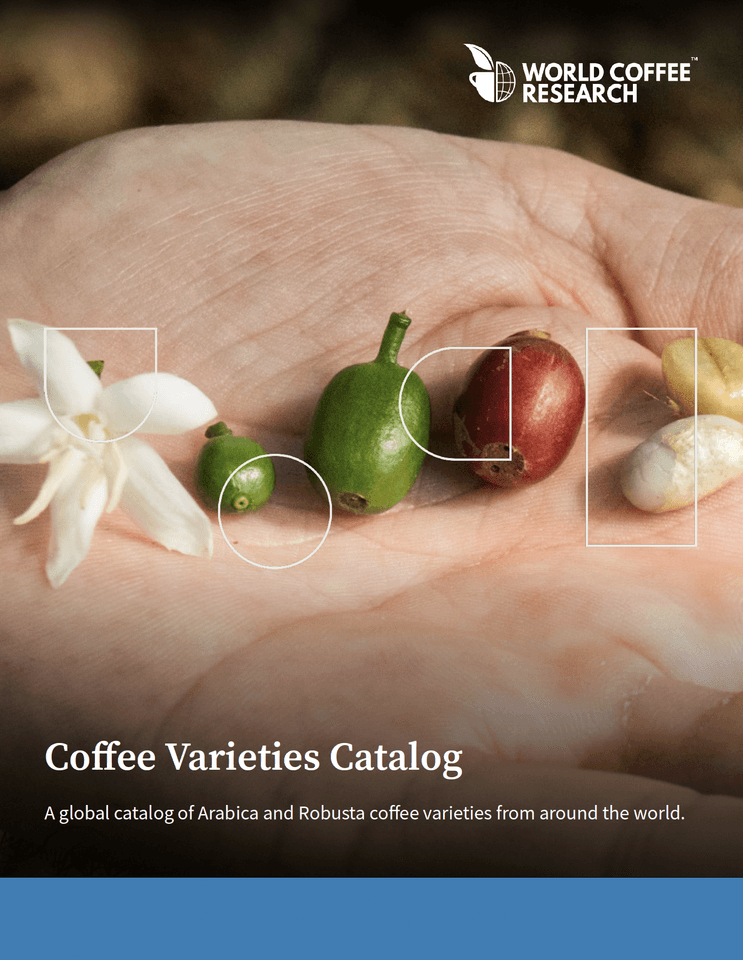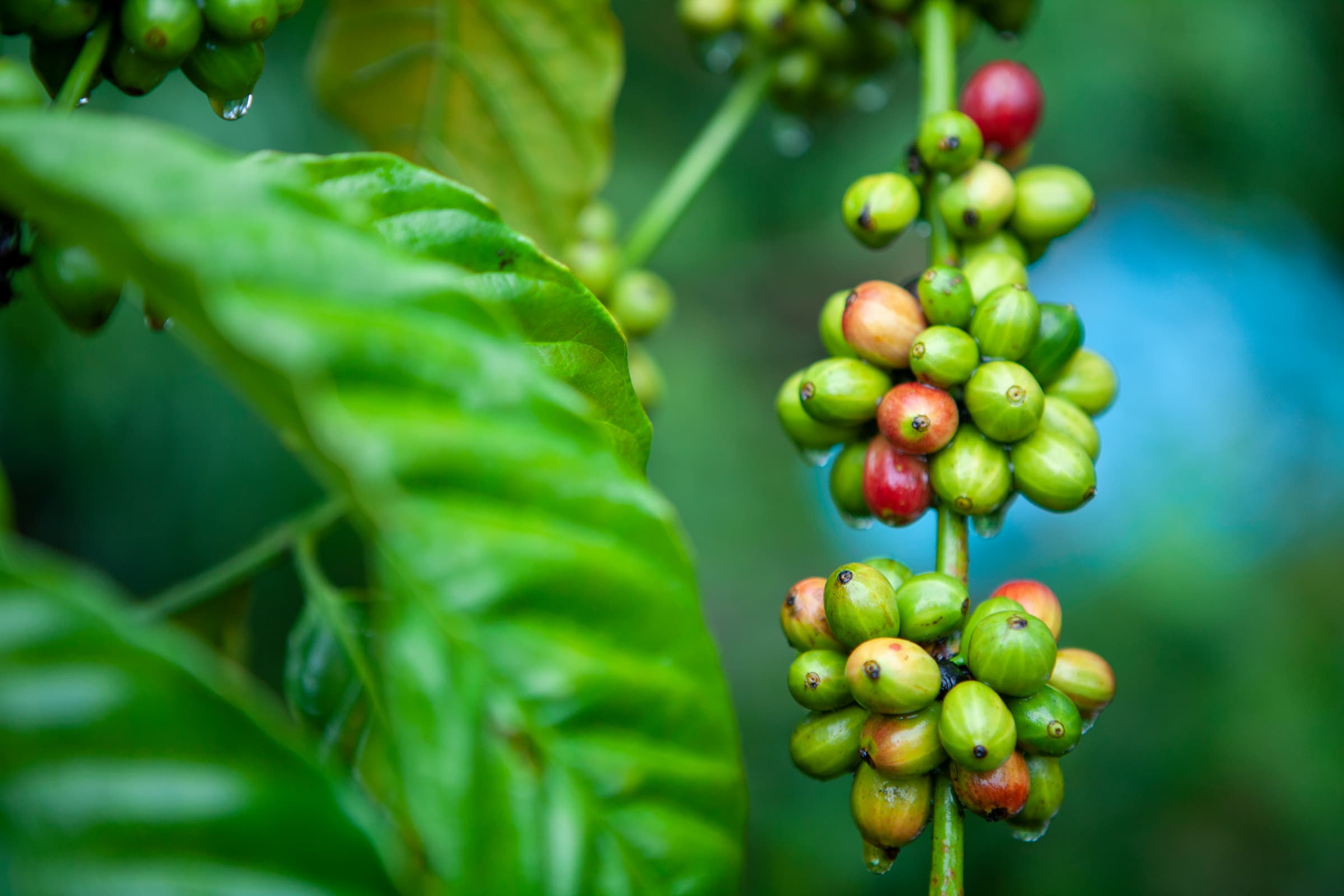The roots of Robusta—cultivating growth for a species once overlooked
How World Coffee Research is fast-tracking innovation for robusta to forge the future of coffee
This is an extended version of a story originally published in Issue 22 of the Specialty Coffee Association's 25, which you can read here.
The roots of Robusta—a species of coffee plant visually recognizable by its uniquely large blossoms and wide, spreading canopy—trace back hundreds of thousands of years to the humid, understory evergreen forests in tropical areas of central and western sub-Saharan Africa, a region with expansive geographic distribution from Guinea to Uganda to Angola.1
Throughout history, the species has been grown in numerous forms and ecotypes, and in regions beyond its birthplace. In our current moment, robusta is grown in about 20 countries across the globe, which are characterized by warm climates and/or high humidity. Robusta’s genetic diversity is vast, and while scientists have been researching the extent of this since the 1980s, there is still much to be uncovered about this species. Even so, today, one thing about robusta is certain: it has dramatically evolved into a major market force and has become an integral agricultural tool as we forge the future of coffee.
In recent decades, robusta cultivation has steadily grown, rising from 25% to 40% of total global coffee production since the early 1990s.2 Until now, arabica held reign over most of the coffee market due to preferences for its cup quality, but many factors, including the increasing demand for coffee, have led to expansions in robusta production. In the last year alone, 177 million 60-kilogram bags of coffee were consumed worldwide—a 2.2% increase from the 2022-23 production year and a striking 4.5% jump from 2019-20203—and demand is not expected to slow down.
With soaring demand at center stage, the effects of climate change, which are only exacerbated by the limited historical investment in coffee's innovation, offer a bleak backdrop for farmers, producing countries, and others across the coffee value chain who are increasingly struggling to keep up. In this reality, a turn toward the inclusion of robusta is practical and necessary. Yet, understanding of arabica’s sister species is somewhat limited among buyers, consumers, and scientists alike, and its full potential in filling market demand for high quality, supply, and climate resilience has yet to be realized.

Freshly picked robusta cherries at World Coffee Research's farm in El Salvador, April 2024.
The story of a species
Cultivation of Coffea canephora Pierre ex A. Froehner, commercially known as robusta, began around 1870 in Congo, using genetic material from Zaïre’s Lomani River region, now known as the Democratic Republic of Congo,4 though it is likely that small-scale production by individual farmers and their families had been ongoing for decades prior to this point. A subtype of robusta called “koillou” (later renamed “conilon” via linguistic distortion when it was introduced to Brazil) was observed in the wild by the French in 1880 between Gabon and the mouth of the Congo River, mainly along the Kouilou-Niari River region. The species was named C. canephora by the botanist Louis Pierre in 1895. Pierre, who worked in France at the Muséum National d’Histoire Naturelle, received a sample of the plant collected in Gabon by the Reverend Théophile Klaine. The name was first published along with a description of the species by Froehner in 1897.
One year later, Edouard Luja, in preparation for the 1900 Paris Exposition, was sent to collect 10 species with economic potential in what is now known as the Democratic Republic of Congo (DRC). During this mission, Luja collected several thousand seeds in the surroundings of Lusambo of a “new” coffee species from an early robusta plantation in the region. Belgian Congo became one of the principal diversity centers, from which new lines were distributed throughout the tropics.
At the turn of the century, the species began to spread to other parts of the world. Robusta seeds from Congo were sent to Brussels, and from there it was sent under the name “robusta” to Java, Indonesia, where it was quickly accepted by farmers due to its high productivity and apparent resistance to coffee leaf rust,6 as a major outbreak of the disease on C. arabica plants occurred in Southeast Asia in the late 1800s. In fact, it was in Indonesia that pioneering, systematic robusta breeding was first conducted.7 These materials were later enriched with those from Gabon and Uganda. Around the same time, other robusta material selected from wild populations was brought to areas of Ivory Coast, Guinea, and Uganda.8
From here, robusta continued to move around the world, entering India by way of Java, with later introductions from west Africa. Material selected in Java was reintroduced to central Africa from 1910 onward, and to the Belgian Congo in 1916 at the Instiut National pour Étude Agronomique du Congo (INEAC), which served as the home to the majority of selection from 1930 to 1960. Within Africa, robusta grew in Madagascar, Uganda, Ghana, and the Ivory Coast, often intermingling endemic variants through crossing with those introduced from commercial production in other parts of the continent.
Robusta was later introduced to Latin America, and in particular, in 1912 the conilon group was introduced in Brazil to Espiritu Santo. Additional commercial introductions in Central America via Guatemala occurred between 1930–1935. It was only after the 1960s that more targeted, globally coordinated robusta collection and exchange was conducted from “centers of domestication,” with the establishment of genebanks in Cameroon, Ivory Coast, Madagascar, and India.9 Further, germplasm collections were established at the Tropical Agricultural Research and Higher Education Center (CATIE) and International Coffee Collection (CICC) in Costa Rica. These institutions introduced robusta plants called “French lines” between 1981–1983. It is worth noting that wherever robusta germplasm has been introduced, it faced—and continues to face—significant management and genetic erosion challenges.
In present day, just six countries—Vietnam, Brazil, Indonesia, Uganda, India, and Côte d'Ivoire—produce 95% of the world’s robusta.10 Laos, Tanzania, Madagascar, and Thailand follow these nations in production, comprising the remainder of the top-10 producing regions worldwide. Countries that lie within Asia and Oceania are collectively the largest producers of robusta, generating 60% of the world’s output at 41.5 million 60 kg bags annually. This region is followed by South America, which produces 28% of the world’s share of robusta, generating 19.8 million bags of coffee in the 2020-21 year.

A fountain of potential untapped
As noted previously, much of the movement of robusta beyond its centers of origin and domestication and the increase in popularity of its production during the early 1900s may be attributed to the spread of coffee leaf rust, a fungal disease that ravaged arabica coffee plants and still remains of great concern globally.
One of the greatest benefits of robusta production is that some varieties possess an exceptionally high natural resistance to some of the major pests and diseases that impede successful and profitable production, including rust; these plants can often thrive under harsh conditions.11 This is one of the reasons why colloquially, C. canephora is often simply referred to as “robusta,” as described and commercialized by Linden in 1900.12
While robusta possesses innately desirable attributes—as most species of coffee do—it also faces considerable challenges which exist across the geographies in which it is cultivated. For example, one of the primary threats to long-term, sustainable robusta production is lack of profitability, which is caused by numerous factors, including heightened labor costs, increased competition from other crops, and lower productivity per planted area in some regions.13 In addition, despite its oft-cited “robustness,” robusta is still sensitive to environmental disturbances. Robusta plants generally have high precipitation needs, and recent research suggests that robusta’s ability to thrive in hotter climates may have been previously overstated—temperatures over 20.5 degrees centigrade can have a significantly negative impact on yields.14 Additionally, many robusta varieties are somewhat susceptible to key diseases and pests, such as coffee leaf rust, coffee wilt disease, red blister disease, stem borer, coffee berry disease, coffee berry borer, and nematodes, among others.15
Even with these limitations, a bulk of the interest in ramping up robusta production today still resides in the fact that it can be grown in a wider range of climates and elevations compared to currently available arabica varieties, which requires a different set of conditions in order to thrive. For example, at lower elevations between 200-800 meters above sea level, robusta plants can produce high crop yields and maintain a reasonable stress resilience to risks, requiring less maintenance via herbicide and pesticide.16,17

Robusta rootstock seedlings. Photo by Armin Hari.
“Both arabica and robusta have their place in our industry—both species being options for farmers to choose from according to their unique locations. Oftentimes, robusta can grow in places not suited for arabica, and vice versa,” says Emilia Umaña, Senior Manager of the Nursery Program for World Coffee Research (WCR). “However, one of the main benefits of robusta is that its vegetative propagation is faster and more cost-effective than arabica. For example, grafting and top-working techniques are more successful in this species.”
Ongoing climate predictions of rising temperatures and altered precipitation patterns by 2050 indicate that cultivation of today’s coffee varieties in current growing areas may no longer be sustainable in the coming years, and the world is facing supply shortages of millions of bags as soon as 2030. To address this shortfall, WCR is breeding new arabica varieties through the Innovea Global Coffee Breeding Network to ensure the species is more climate resilient—investing in innovation to improve populations and adapt them to the environments of the future. To enable the industry to meet growing demand, though, these realities are likely to in turn increase the production of robusta by a significant margin,18 underscoring the need for further research to enhance the positive and market-desired traits inherent to the species.
One caveat that is pervasive in the conversation about robusta’s heightened prevalence on the market is that its beans generate differences in terms of taste and cup quality, which is the reason for its long-disparaged taste. For instance, coffee brewed from robusta beans is often lower in acidity, higher in bitterness, and more “full-bodied” due to its pyrazine content,20 an aromatic known for its earthiness. But, as many in the industry already know by now, when handled and processed properly, robusta can serve as a product for specialty markets.21
“The new trends in processing robusta are using fermentation as a crucial step to improve quality,” says Dr. Veronica Belchior, WCR Research Scientist for Coffee Quality Evaluation, “Fermented robustas are often cited as cleaner and show a wider spectra of descriptors—mostly winey, whiskey, and some positive herbal notes.”
Agronomic and post-harvest processing efforts can make an immediate and crucial difference on robusta production and quality. With this, though, as the coffee industry considers an increase in robusta production as a solution to impending supply shortages and climate-related challenges, it will inevitably seek to unlock the species’ untapped potential to optimize its performance in the field and its cup quality on a commercial scale—and that’s where science enters the scene.
Discovering diversity
Robusta coffee has a wide scope of genetic diversity. Wild populations are the primary genetic relative of robusta coffee, and cultivated coffee has changed relatively little from its wild progenitors. It is also a secondary genetic relative of arabica, conferring potential disease and pest resistance.22 Even so, there are many unknown variations, including traits related to cup quality, in the robusta gene pool. By and large, these hidden variations are yet to be explored by scientists.
“Previous genetic studies show that C. Canephora has high diversity and various distinct sub-populations,” says Dr. Jorge Berny, WCR Research Scientist in Breeding and Genomics. “Nevertheless, utilizing the beneficial variation across groups has been lacking, as the populations and breeding efforts remain relatively isolated. Deepening the understanding of the species’ diversity, and its integration, is a crucial part of continuous and long-term genetic gains.”
Many different common terms are used to describe robusta in the areas where it is grown. These terms include “robusta,” “conilon,” “nganda,” “koillou/quillou,” and others. These terms are generally regional, colloquial, and do not necessarily correspond to specific genetically distinct varieties/clones that have been developed and released by breeders over the years. There are many reasons for the obfuscation of robusta’s genetic diversity. Because robusta necessarily cross-pollinates—a single robusta tree cannot successfully pollinate its own flowers, as arabica trees can do (scientists call this “allogamous”23)—and is predominantly outcrossing, subtypes grown in the same field typically interbreed.24
A result of this mating system is that a portion of currently cultivated robusta comprises either trees originating from open-pollinated seeds25 or multi-line clones. With this, robusta plantations are not typically genetically uniform; as a result, many farmers have little awareness of which varieties or subtypes they are growing.
What scientists do know is that robusta is a diploid species divided into two broad genetic groups, Guinean and Congolese. The Guinean group—which is generally characterized by narrow internodes, high caffeine content, low bean weight, drought resistance, secondary branching, and early harvest—originated in central-west Africa, while the Congolese group—which is typically characterized by higher rust resistance, medium caffeine content, high bean weight, drought susceptibility, big internodes, tall growth, and late harvesting—originated in central Africa.26 Among these two groups, the Congolese is the most widespread. In addition, within each group, there are different populations or subgroups.
Research into the genetic relationships within the species shows that, in general, these populations are well differentiated and genetically isolated.27 In the shadow of the unforgiving climate crisis and its increasing spillover effects, World Coffee Research scientists recognize that uncovering robusta’s genetic diversity will unlock great potential for the industry to tactfully harness the species’ positive attributes for the benefit of all.

Arabica Coffee Varieties
Cultivating growth
The world may soon face challenges in keeping up with rising demand for robusta just as it currently does for arabica. For instance, in March 2024, Vietnam’s agriculture department projected that its national coffee production this year could drop by nearly 20% due to drought, and in April, coffee prices surged on the heels of a heavy rainfall event in Minas Gerais, Brazil that will undoubtedly affect the country’s coming harvest year and supply. WCR’s 2023 study of opportunities for robusta variety development produced in conjunction with AbacusBio predicts that the industry may face potential robusta shortages estimated to reach up to 35 million bags per year.
In the face of this prediction, the lack of collaborative and global breeding efforts in place for robusta is alarming. While some strong breeding initiatives have taken shape at national coffee institutes across Asia, Africa, and Latin America, there is still a clear opportunity for scientists to better understand robusta’s genetic diversity and tap into it via modernized breeding initiatives to strengthen the species’ long-term viability for farmers and selectively improve cup quality.
In parallel with its arabica breeding efforts, WCR has recognized the need for genetic improvement in robusta on a global scale and the organization is starting to build the foundation for a robusta breeding program, which is slated to launch in partnership with key producing countries in 2025. While the program is in its early stages, WCR’s breeding team has already initiated crosses of plants at the organization’s research farm in preparation for the official roll out, with a keen focus on traits like yield, disease resistance, and climate resilience to ensure that resulting varieties are suitable for farmers’ respective needs.
In other words, the robusta breeding program’s design is demand-led—meaning it is inclusive of the perspectives of those already involved in the species’ value chain, from the production and processing level to the marketing and consumption ends of the stream. Ultimately, this approach facilitates co-creation and co-ownership, all of which are key to ensuring that robusta breeding outcomes and impact are both relevant to farmers and durable against the production challenges of the future.
In addition, as WCR continues these efforts, the technical team will make breeding decisions that work toward achieving specific quality targets to improve the taste of robusta and meet the demands of farmers, buyers, traders, and consumers alike. “We are planning to do sensory evaluations that are already known for canephora coffees, using the Coffee Quality Institute (CQI) form to evaluate robusta with a particular definition of the roasting profile,” says Dr. Belchior. “It’s important that robusta and arabica are evaluated in different ways, using specific protocols. We hope to map the quality for robusta and arabica together, though, and this may allow us to introduce new quality targets in the breeding program.”
Enhancing robusta production and increasing quality is a significant undertaking, and while the timelines for genetic improvement are long—especially as WCR considers its goals in fulfilling far-reaching, global impact for the farmers of tomorrow—the organization is executing intersecting initiatives to support the farmers of today. Efforts to support robusta nursery infrastructure offer promise in ensuring immediate availability of officially released varieties and that genetic improvements are maintained over time through good agricultural practices.
For instance, in 2023, WCR initiated work alongside local partners to understand the challenges and opportunities for robusta propagation via a project in Uganda, which aims to increase the ability of local nurseries to supply improved varieties in the country. The project’s goal is to move 100,000 healthy, coffee wilt disease-resistant NARO Kituza Robusta (KR) plants into farmers’ hands, while also increasing the future supply of good-quality plants by increasing knowledge operations about how to propagate healthy, disease-resistant seedlings. These interventions reinforce lessons that can be applied in other nations and help pave the way for later variety releases to occur more quickly.
In addition, over the last two years, World Coffee Research created numerous resources to advance knowledge of the robusta landscape and support enhanced production, including a focus report on the future of robusta quality, an updated coffee varieties catalog now featuring robusta varieties, a nursery training manual and best practices guide for grafting robusta, and a video series on robusta clonal coffee nursery management.
“Robusta coffee is a very important asset to Ugandan coffee farmers,” said Maureen Namugalu, Uganda Country Project Manager for WCR. “The distribution of Uganda’s exports are 80% robusta and 20% arabica, and the country’s coffee road map highlights, among its other initiatives, the relevance of planting material in increasing production and productivity. This increase will be possible through the implementation of strategies that ensure quality planting material gets into the hands of farmers, and supporting them with training on the right techniques on how to best propagate these materials.”

Healthy robusta cherries. Photo by Armin Hari.
Clearing a path
As scientists race to ensure the continued sustainability and climate resilience of arabica and robusta takes its seat as a major market force, it is clear that the coffee industry is sitting at a precipice. We are grappling with the historical lack of investment in coffee’s innovation and the resulting myriad of challenges impeding successful production, and not only is the supply and quality of coffee at stake, but the millions of livelihoods of those who primarily depend on coffee’s longevity are as well. Clearing a path for transformative innovation for robusta as we are doing in arabica can help safeguard the wellbeing of our communities.
We are sitting at a fork in the road: one that has inspired WCR on its new journey in developing a plan to shepherd the industry into tomorrow—forming a special network with strategic, globally coordinated partnerships unlike any other that has come before it—all to achieve the major breakthroughs needed to forge the future of our favorite crop.
1 Dussert et al, 1999.
2 See Opportunities for Robusta Variety Innovation, Table 5 (p. 13).
3 International Coffee Organization, Coffee Market Report, April 2024. https://www.icocoffee.org/documents/cy2023-24/cmr-0424-e.pdf.
4 Berthaud & Charrier, 1988.
5 Benoit, 1968
6 Cramer, 1957
7 Ferwerda, F.P. Coffee breeding in java. Econ Bot 2, 258–272 (1948). https://doi.org/10.1007/BF0285...
8 Charrier and Eskes, 1997.
9 Bramel, et al., 2017.
10 AbacusBio (2023). Opportunities for robusta variety innovation [white paper]. World Coffee Research. https:// worldcoffeeresearch.org/resources/robusta-innovation.
11 Campuzano, et al., 2022.
12 Dagoon, 2005.
13 Compare 1.9 bags/ha in Côte d’Ivoire to 10.4 or 47.7 bags/ha in Uganda and Vietnam respectively.
14 Kath et al., 2020, Tournebize, et al., 2022.
15 Vega et al., 2006.
16 Goldemberg et al., 2015.
17 Daviron & Ponte, 2005.
18 Bunn, et al., 2015, Kath, et al., 2023, Dinh, et al., 2022, Kath et. al, 2022, de Aquino, et al., 2022.
19 Leroy, et al., 2006.
20 Miyanari, 2008.
21 Uganda Coffee Development Authority, 2019.
22 Chadburn & Davis, 2017.
23 Nowak, et al., 2011.
24 Thomas, 1935.
25 Labouisse et al., 2020.
26 Herrera and Lambat, 2017. Kiwuka et al., 2021.
27Berthaud, 1986, Montagnon, 1992, Cubry, et al., 2008, Musoli, et al., 2009, Dussert et al., 1999, Gomez et al. 2009, Mérot‑L’Anthoëne et al., 2019.